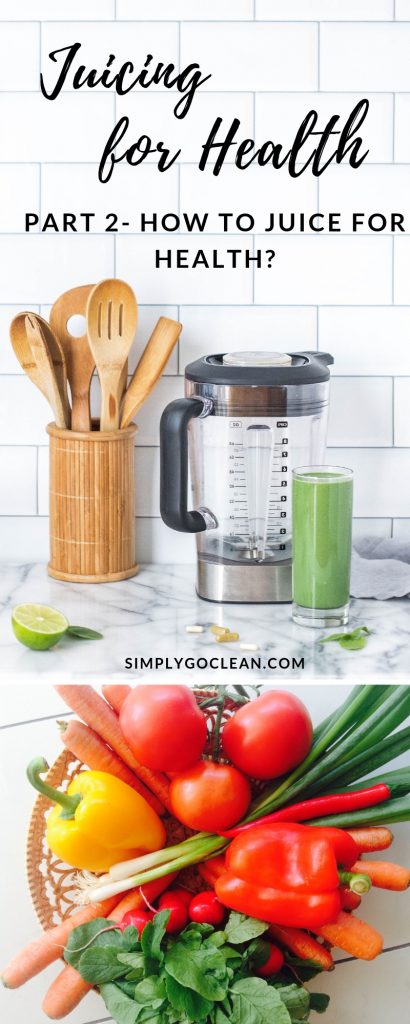(Part 2 of Juicing for Health)
Juicing is all the rage and seems to be an easy and convenient way to cram
That’s what we’re set off to find out.
In Part 1 – Is Juicing really good for me?, we’ve looked at the potential benefits and downsides of juicing in terms of nutrients.
In Part 2 – How to Juice for Health, we’ll go through the steps required to juice to improve your own health.
What do I need to get started?
Unfortunately, there’s no easy shortcut here, you might need a juicer. Preferably a decent one.
Why?
Regardless of whether you want your juice to be pulp-free or not, since we’ve seen in Part 1 that extra fiber *does* have a lot of benefits, you want to preserve as much of the nutrients in your juices as possible.
But which one best preserves nutrients, a blender or a juicer?
There’s actually a lot of controversy on that subject and not that much scientific information online. I found this video below, which seems to make a lot of sense and walks the walk.
So basically, the sources of nutrient losses can be of 3 types: through heat, oxidation from air and oxidation over time.
Heat is ruled out as even a 1-minute blending time isn’t really enough to create much damage.
However, a blender works by aerating the fruits and vegetables at high speed, typically for 1 minute. Which is much longer than the time it takes to juice the same amount of fruits and vegetables. This is where a lot of the nutrients are lost.
Centrifugal juicers, which use blades to chop the fruit/vegetable and centrifugal force to separate the pulp from the juice, are faster than blenders. But again, a lot of nutrients are lost due to oxidation from air during the juicing process. They are, however, notably cheaper than their masticating counterpart.

So a slow masticating juicer, like the Hurom, reviewed here, is best for nutrient content. They are more expensive though.
If you need more information on which equipment might best suit your budget and your health needs, this post on juicers vs. blenders might help.
So do I need a blender at all?
Well, yes, preferably. See, a blender has many other uses (sauces, soups, and, ahem… cocktails…). So it’s well worth having in the kitchen anyway.
It also allows for a wider variety of food to be added, such as nuts, bananas, avocados. Those might make the difference between your kids turning their nose up at your glass of green goodness, or guzzling them down.
Or between needing to eat something more substantial at 10 am or going through the whole morning on your glass of green stuff at breakfast.
If unsure about the juicer/blender situation, I have covered their pros and cons in a separate post.
Calcium, the odd one out
From the above video on nutrient retention in juicers vs. blenders, it also came out that calcium levels were higher in the tested smoothies than in juices.
This is important if you need more of the strong stuff, in case of osteoporosis, for example.
How to juice/blend for health
OK, so far, we’ve covered
…the reason why juicing might be beneficial, by allowing the body to benefit from more nutrients from fruits and vegetables (Part 1 – Is Juicing really good for me?)
…the tools you’ll need, whether it’s a juicer or a blender (or both)
So how can I choose the fruits and vegetables to best suit my own body?
Remember, fruits should only be a treat…

Aim for local, seasonal and organic fruits to ensure that you get more nutrients and a good variety of them. This is essential to ensure that your digestive system receives the whole range of antioxidants, enzymes, prebiotics,
Find what fruits and vegetables work for you
Everybody is different, therefore
I would know. If I were to follow the USDA’s MyPlate guidelines, the grains and dairy components would be sending me cramping within 2 hours. Even if I tried to follow the Mediterranean diet, whole grains and fruits would quickly be an issue. To be comfortable, I need more vegetables that the ketogenic diet suggests, and far
So listen to your body. Carefully. Attentively. Regardless of the pleasure provided by the taste or texture, how does your body feel after eating specific fruits or vegetables? It can be right after (think heartburn, hives or other allergic reaction), a few hours later (digestive disturbances, headache, major energy slump) or even in the next few days (eczema, fatigue).

You might need to keep a Food Journal for a while, to pinpoint what food can cause this or that symptom. If carrying a notepad with you and remembering to write down everything you eat seems daunting, try an app, like Cara, to keep a tab on your food and water intake on the go.
The key is to shut out all the fads and trends out there, to take a good hard look at what we are putting in your mouth, and to be mindful of what that food does to our body.
Do your research
If you do a quick Google search on “best food for…” and select a few serious, research-based websites, you should come up with a few ideas already. Just make sure the website has done their research and that the claims are backed.
If you have no issues to report (lucky you!), then feel free to experiment with colors and flavors at your leisure. The more varied the juice, the better, as your body gets a good variety of nutrients. So knock yourself out!
My Juicing for Health Hack!
This website, JuiceRecipes.com is an awesome starting point. Pick your health conundrum, whether you want to prevent something or cure something, and all the juice recipes that can help come up. You can check the benefits of each one by clicking on it.
However, do check the comments left by fellow juice guzzlers. If a lot of them complain about the taste, find another recipe. We want to create daily healthy habits here, so better make the experience pleasurable!
Remember,
Let food be thy medicine and medicine be thy food. Hippocrates
Juicing is only one way to get more of the right stuff in your body.
A word of caution…
Once you get clued up about what fruits and vegetables your body actually
I now just eat my baby spinach raw as a side salad and my fruits whole during the day, thank-you.

But juicing definitely can help you quickly absorb nutrients from fresh produce that you would normally not eat raw, or not in those quantities. Think beet, cruciferous vegetables, carrots, leafy greens, ginger, etc.
So get those juices flowing!
Juiced or blended, green, purple or orange, just get in there and give it a try. Our diet is naturally fairly poor in nutrients and our needs for nutrients have never been so high. Stress (let’s face it, who isn’t stressed these days?) depletes our B and C vitamins, magnesium and iron levels, among others.
So we all need to find affordable, convenient ways to add more of those vitamins and minerals into our daily diet. Juicing might just be that solution for you.
If you’re still not sure whether Juicing is actually any good for you, you might want to read Part 1 on Juicing for Health.
Try it, and let us know how it worked for you and what your favorite recipe is in the comments below.
And feel free to get inspiration from Pinterest for those juice recipes!
Disclaimer: Please note that this post relates to my own personal story and information I have gathered from my own research and experience. I am not a dietician, a nutritionist or a doctor. If you suffer from any chronic conditions, are being followed by a doctor, or take medication, please see your doctor before making changes to your diet or embarking on a juicing fast.






I have got a good idea How to juice. thanks for your post
Hi Jhon, thanks for stopping by, juicing is the way to go, apples and all!
Go well, Isabel
Hi Isabel,
Great post! Juicing was a real turning point for me on my road to improved health. After I got past the first few days, it was pretty easy. I felt great and brain fog started to dissipate.
I was chuckling to myself about you mixing multiple ingredients together because I did the same thing and it was gross.
I learned that juiced yams are a no for me. I also learned that nothing can disguise the taste of beets, so now I just roast them as a side dish.
I finally settled on carrot/celery juice and apple/pear (watered down), each with a splash of fresh lemon juice.
This post reminds me that I need to do a fast as soon as the fresh veggies are availabe! Thank you for the updated information…I need new recipes.
Hi Irma, thanks for stopping by, it’s always a pleasure to see you around! I think the “going all out” mistake is one most juicing aficionados make at some point of other! lol
We live and learn… I also stick with spinach as a side dish these days, gave up trying to cram too much of those in my juices. It needs to stay a pleasure, so it’s important to find what works for you, what doesn’t, and pick your battles!
Keep well, eat well,
Isabel
I like to drink beetroot juice. This is the season for this juice, and in the winter i take it on regular basis. It is also a fact that it is considered to be the best for stomach.
Hi there, yes, beetroot juice is a must-have in my book. Especially when they’re in season!
Thanks for stopping by, go well, Isabel